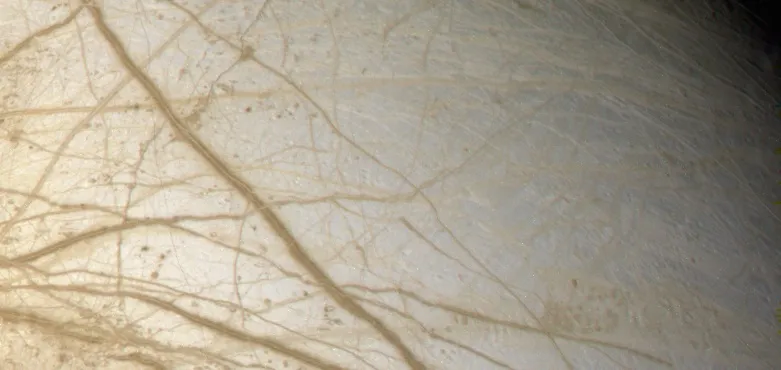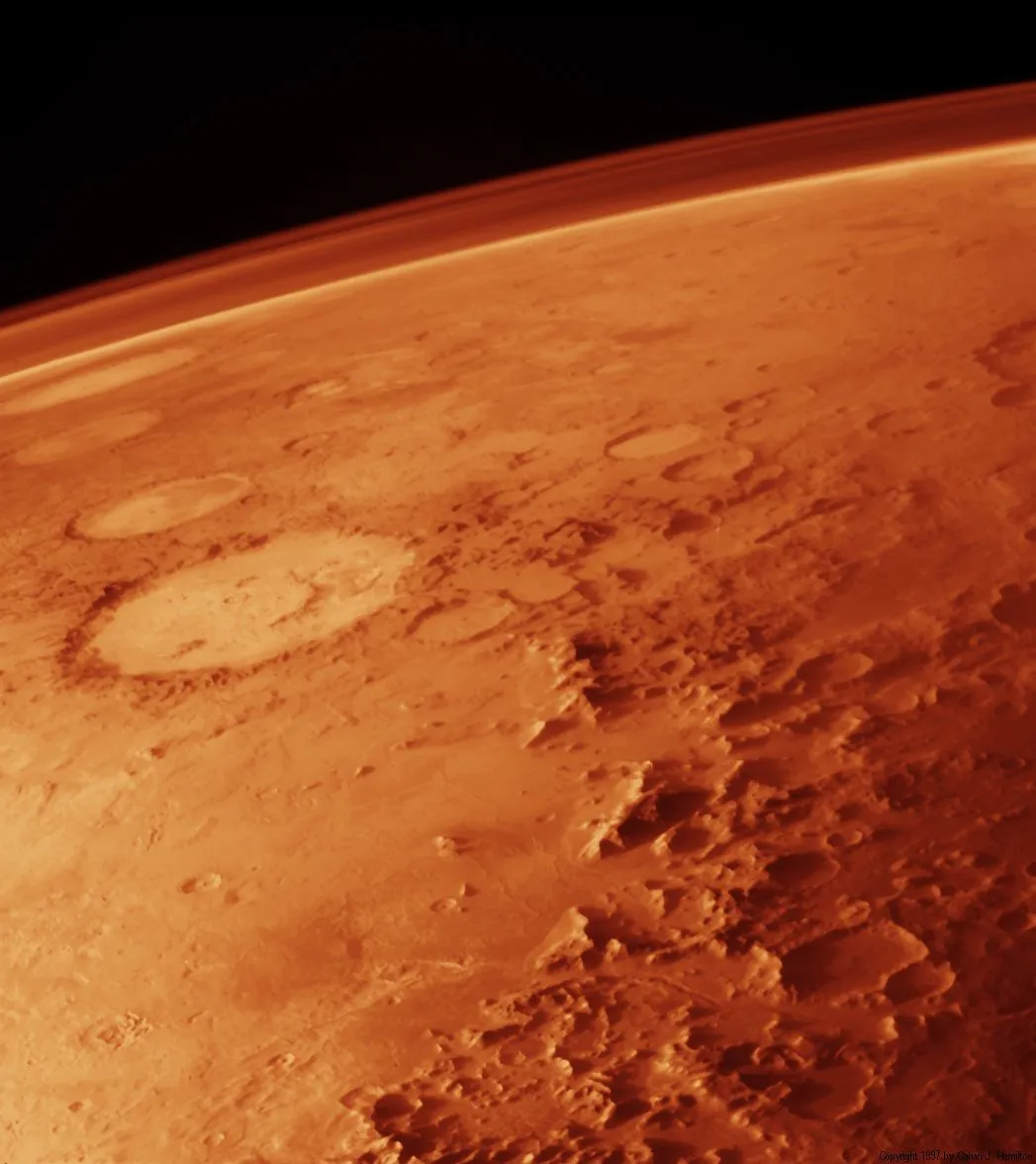Where in the Solar System Are We Most Likely to Find Life?
A number of interplanetary destinations could harbor extraterrestrial life—finding it could be just a space mission away
/https://tf-cmsv2-smithsonianmag-media.s3.amazonaws.com/filer/11/4a/114aae05-1e5c-472e-905b-b31f68480ba9/europa.jpg)
Last week, NASA announced one of its most exciting missions in recent memory: a plan to visit Europa, one of Jupiter's largest moons. Previous research has shown that the moon is covered with water ice, and may contain a liquid ocean underneath its surface—raising the tantalizing possibility that Europa could harbor life.
In recent years, the remarkable number of planets we've discovered orbiting distant stars (1780, at latest count) has shifted the focus of the search for extraterrestrial life to other solar systems. But these planets are far, far away, so it would likely take thousands of years to reach even the closest ones.
With the Europa announcement, it's worth remembering that there are a number of destinations here in our own solar system that we could visit (with unmanned probes) during our lifetimes and perhaps find life. Here's our rundown of the best bets:
Europa
A number of missions, including the 1995 flyby of the unmanned probe Galileo, have provided data on Europa that have led scientists to some interesting conclusions. Its surface is made of water ice, but is surprisingly smooth—it has a number of cracks, but very few craters—suggesting that the ice is likely of a relatively young age, and is continually reforming over time, erasing the effects of asteroid impacts.

Moreover, analysis of Europa's lineae (dark fractures that crisscross the ice's surface) shows that they're gradually moving, perhaps evidence of tectonic activity or volcanic eruptions underneath. If true, this activity could provide enough heat to generate a liquid ocean underneath the ice.
The hypothetical combination of volcanic activity and liquid water has prompted some scientists to speculate that Europa could harbor life, perhaps similar to the ecosystems on Earth that crop up around seafloor hydrothermal vents and flourish in the absence of sunlight.
Last year, data from the Hubble telescope indicated that in some spots, enormous jets of water are actually shooting out through small holes in Europa's icy surface. If NASA really does send a probe to the moon sometime during the 2020s—still a big if, due to the realities of government spending on space—it could fly through these jets and collect samples to search for extraterrestrial life.

Enceladus
Saturn's moon Enceladus is tiny: Its diameter is about four percent that of Earth's, about the width of Arizona. But in recent years, scientists have become convinced that the minute moon is about as likely to harbor life as Europa, for largely the same reason—it appears to contain a liquid water ocean under a cover of ice.
In 2008, NASA's Cassini-Huygens probe detected plumes of salty water vapor shooting out from the moon's south pole, and further analysis of the plumes confirmed the presence of organic molecules such as carbon, nitrogen and oxygen, thought to be necessary for life. Instead of a thick cap of ice, similar to the one found on Europa, Enceladus has a thinner coating of ice mixed with crust, and the speed at which these plumes were moving (upwards of 650 miles per hour) strongly suggest that they're being shot out from a liquid ocean present at the moon's southern pole.
The presence of liquid water—perhaps due to heating caused by the moon's natural radioactivity—along with rock, ice and vapor has led scientists to hypothesize the existence of a long-term water cycle, in which vapor is shot upward, settles back down to the planet's surface and condenses into a liquid, circulates deep into the moon's crust and then rises back to the surface over hundreds of thousands of years. This could hypothetically circulate the organic molecules over time, making the existence of microbial life on the tiny moon that much more likely.
The Cassini-Huygens probe is schedule to pass by the moon several times in 2015, but there are currently no plans to send a specialized probe that could land on its surface, or sample the water vapor plumes for evidence of life.

Mars
Because of its close proximity, we know more about Mars than any of the other destinations on this list, and much of what we've found is encouraging. Data from the Curiosity rover and other unmanned probes have provided evidence that the planet once featured flowing liquid water and freshwater lakes on its surface. The planet currently has permanent ice caps on each of its poles that are largely composed of water ice, and the soil contains about one to three percent water by mass, although it's bound to other minerals and thus inaccessible. There's also some evidence that the planet's crust might feature traces of organic compounds.
The one thing we haven't found, though, is indisputable evidence of life, either current or historical. Previous claims of microbial fossils found on meteorites that originated on Mars have been debunked, and all the soil and rock samples that our probes have analyzed have failed to provide a clear signature of any life form. Other aspects of Mars that seem to make current life unlikely are its extremely thin atmosphere (too thin to substantially protect against radiation from space) and its extreme cold (average surface temperature: -82ºF), which prohibits liquid water from forming at the surface.
Still, some scientists believe that the historical evidence of liquid water suggests that Mars was once much more hospitable than it is today. Studies indicate that the planet likely once had a magnetic field, which could have protected against radiation and also helped preserve a thicker atmosphere against the erosional force of the solar wind. This atmosphere could have insulated the planet, raising temperatures to levels high enough to produce liquid water, the key to fostering microbial life.
We currently have two rovers exploring and sampling Mars, along with plans to send yet-more sophisticated probes and perhaps even a manned mission in the future. If life did once exist on Mars and left any evidence, with luck we'll eventually discover it.

Io
Jupiter's third-largest moon, Io is incredibly volcanic: With more than 400 active volcanoes, it's believed to be the most geologically active body in the solar system. All this activity has produced a thin gas atmosphere, mostly made up of sulfur dioxide, with traces of oxygen.
In some areas of the surface, it also produces heat. Regions near volcanoes have been found to be as hot as 3000ºF, while other areas average about -202°F, meaning that some areas could persist at a happy medium that's conducive to life.
Unfortunately, Io isn't nearly as likely to harbor life as Europa or Enceladus for a few reasons: It hasn't been found to have organic chemicals or water (either in a liquid or solid state), and and it orbits within a ring of radiation (called the Io plasma torus) surrounding Jupiter, formed by ionized gas from Io's own volcanoes, that would likely kill anything.
However, some scientists believe that Io could have harbored life long ago and that it could even persist deep under the moon's surface. Computer simulations of the formation of Jupiter's moons suggest that Io formed in an area with plentiful liquid water. This, combined with its heat, could have fostered the evolution of life. Io's plasma torus would have destroyed all life (and all surface water) within 10 million years or so of the moon's formation, but it's possible that some could have migrated underground into the moon's lava tubes and been sustained by the energy released by volcanic activity.
If life does live on Io, it'll likely be some time before we can find it, as we'd need to land a probe on the moon's surface and drill into its interior to discover it. Building and successfully landing a probe that carries equipment to drill more than a few inches down is still far beyond our capabilities.

Titan
In terms of life, Titan—the largest moon of Saturn—has one thing going for it that none of the other destinations do: a thick, chemically active atmosphere. The moon's atmosphere is denser than Earth's, and the upper levels are mostly composed of nitrogen, with small amounts of methane and oxygen. This is encouraging, as life (at least on Earth) requires an atmosphere for protection from radiation and for the circulation of organic compounds.
For years, though, scientists dismissed the possibility of life on Titan because of its extreme cold. Distant from the Sun and without enough volcanic activity to significantly warm it, the moon's average surface temperature is −290°F, far too cold to allow for liquid water, and life as we know it.
More recently, though, using the Cassini-Huygens probe, scientists have observed liquid lakes on the moon's surface, likely made of hydrocarbons such as ethane or methane. It would look radically different from life on Earth, but it's possible these lakes could harbor life that lives in a hydrocarbon medium instead of water.
There's even speculation that the moon's methane-rich atmosphere is actually the result of life: Normally, the chemical is degraded by sunlight, but if organisms on Titan emitted methane as part of their metabolism, as many microbes on Earth do, it could continually replenish the atmosphere's stock of it.
There has been some talk of sending a "splashdown" probe to explore the surface lakes of Titan, but there are no current plans to do more than examine it from afar with the Cassini probe.
/https://tf-cmsv2-smithsonianmag-media.s3.amazonaws.com/accounts/headshot/joseph-stromberg-240.jpg)
/https://tf-cmsv2-smithsonianmag-media.s3.amazonaws.com/accounts/headshot/joseph-stromberg-240.jpg)